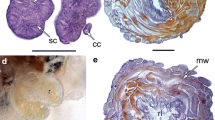Abstract
The ciliostatic activity of exo- and endometabolites of 243 filamentous fungal strains was evaluated byin vitro bioassay using tracheal organ cultures of 1-d-old chicks. Chloroform-extractable metabolites produced in the cultivation medium (25°C/10 d) by 30 out of 72 (41%) investigated strains displayed the ciliostatic activity as did metabolites from the biomass of the spores and the mycelium of 46 other strains (26%). This result could contribute to the clarification of the correlation between fungi and respiratory disorders in some working places and in damp dwellings.
Similar content being viewed by others
References
Amitani R., Taylor G., Elezis E.-N., Llewellyn-Jones C., Mitchell J., Kuze F., Cole P.J., Wilson B.R.: Purification and characterization of factors produced byAspergillus fumigatus which affect human ciliated respiratory epithelium.Infect. Immun. 63, 3266–3271 (1995).
Cole P.J.: Significance ofHœmophilus influenzœ and other microorganisms for the pathogenesis and therapy of chronic respiratory infections.Infect. 15 Suppl. 3, 99–102 (1987).
Dugal F., Girard C., Jacques M.: Adherence ofBordetella bronchiseptica 276 to porcine trachea maintained in organ culture.Appl. Environ. Microbiol. 56, 1523–1529 (1990).
Etievant M.: Mechanisms and control of mucociliary clearance.Bull. Inst. Pasteur 90, 24–266 (1992).
Hingley S.T., Hastie A.T., Kueppers F., Higgins M.L., Weinbaum G., Shryock T.: Effect of ciliostatic factors fromPseudomonas aeruginosa on rabbit respiratory cilia.Infect. Immun. 51, 254–262 (1986a).
Hingley S.T., Hastie A.T., Kueppers F., Higgins M.L.: Disruption of respiratory cilia by proteases including those ofPseudomonas aeruginosa.Infect. Immun. 54, 379–385 (1986b).
Jackowski J.T., Szepfalusi Z., Wanner D.A., Seybold Z., Sielczak M.W., Lauredo I.T., Adams T., Abraham W.M., Wanner A.: Effect ofP. aeruginosa-derived bacterial products on tracheal ciliary function: Role of O2 radicals.Am. J. Physiol. 260, 61–67 (1991).
Jakab G.J., Hmieleski R.R., Zarba A., Hemenway D.R., Groopmen J.D.: Respiratory aflatoxicosis—suppression of pulmonary and systemic host defenses in rats and mice.Toxicol. Appl. Pharmacol. 125, 198–205 (1994).
Jesenská Z.:Micromycetes in Foodstuffs and Feedstuffs. Elsevier, Amsterdam-London-New York-Tokyo 1993.
Jesenská Z., Bernát D.: Effect of mycotoxins onin vitro movement of tracheal cilia from one-day-old chicks.Folia Microbiol. 39, 155–158 (1994).
Jesenská Z., Jaroš F., Jindřichová J.: Filamentous micromycetes in working environment.J. Hyg. Epidemiol. Microbiol. Immunol. 34, 273–281 (1990).
Kamp E.M., Kimman T.G.: Induction of nasal turbinate atrophy in germ-free pigs, usingPasteurella multocida as well as bacterium-free crude and purified dermonecrotic toxin ofP. multocida.Am. J. Vet. Res. 49, 1844–1849 (1988).
Marks P.J., Banks D.E.: The sick building syndrome.Immunol. Allergy Clin. N. Am. 14, 521–535 (1994).
Pavia D., Agnew J.E., Lopez-Vidriero M.T., Clarke S.W.: General review of tracheobronchial clearance.Eur. J. Resp. Dis. 153, 123–129 (1987).
Piecková E., Jesenská Z.: The effect of the heat-stable and chloroform-extractable secondary metabolites of filamentous fungi on the respiratory tract cilia movement on one-day-old chickensin vitro Czech Mycol. 47, 215–221 (1994).
Poulssen O.M., Breum N.O., Ebbehoj N., Hansen A.M., Ivens U.I., van Lelieveld D., Malmros P., Matthiasen L., Nielsen B.H., Nielsen E.M., Schibye B., Skov T., Stenbaek E.I., Wilkins K.C.: Sorting and recycling of domestic waste. Review of occupational health problems and their possible causes.Sci. Total Environ. 168, 33–56 (1995).
Samson R.A., Flannigan B., Flannigan M.E., Verhoeff A.P., Adan A.C.G., Hoekstra E.S.:Health Implications of Fungi in Indoor Environments. Elsevier, Amsterdam 1994.
Sekiya K., Futaesaku Y., Nakase Y.: Electron microscopic observations on tracheal epithelia of mice infected withBordetella bronchiseptica.Microbiol. Immunol. 32, 461–471 (1988).
Sekiya K., Futaesaku Y., Nakase Y.: Electron microscopic observation on ciliated epithelium of tracheal organ cultures infected withBordetella bronchiseptica.Microbiol. Immunol. 33, 111–121 (1989).
Sigsgaard T., Malmros P., Nersting L., Petersen C.: Respiratory disorders and atopy in danish refuse workers.Am. J. Resp. Crit. Care Med. 149, 1407–1412 (1994).
Smith J.E., Anderson J.G., Lewis C.W., Murad Y.M.: Cytotoxic fungal spores in the indoor atmosphere of the damp domestic environment.FEMS Microbiol. Letters 100, 337–343 (1992).
Smoragiewicz W., Cossette B., Boutard A., Krzystyniak K.: Trichothecene mycotoxins in the dust of ventilation systems in office buildings.Int. Arch. Occup. Environ. Health 65, 113–117 (1993).
Stadtlander C., Kirchhoff H.: The effects ofMycoplasma mobile 163K on the ciliary epithelium of tracheal organ cultures.Zbl. Bakt. 269, 335–365 (1988).
Su H.J., Rotnitzky A., Burge H.A., Spengler J.D.: Examination of fungi in domestic interiors by using factor analysis—correlations and associations with home factors.Appl. Environ. Microbiol. 58, 181–186 (1992).
Summerbell R.C., Staib F., Dales R., Nolard N., Kane J., Zwanenburg H., Burnett R., Krajden S., Fung D., Leong D.: Ecology of fungi in human dwellings.J. Med. Vet. Mycol. 30, 279–285 (1992).
Summerbell R.C., Staib F., Ahearn D.G., Ando M., Ajello L., Crow S.A., Fung D., Gregor T., Noble J., Price D.L., Simmons R.B., Tarlo S.M., Woychuk W.: Household hyphomycetes and other indoor fungi.J. Med. Vet. Mycol. 32, 277–286 (1994).
Verhoeff A.P., van Wijnen J.H., van Reenenhoekstra E.S., Samson R.A., van Strien R.T., Brunekreef B.: Fungal propagules in house dust. 2. Relation with residential characteristics and respiratory symptoms.Allergy 49, 540–547 (1994).
Verhoeff A.P., van Strien R.T., van Wijnen B.: Damp housing and childhood respiratory symptoms: The role of sensitization to dust mites and molds.Am. J. Epidemiol. 141, 103–110 (1995).
Author information
Authors and Affiliations
Rights and permissions
About this article
Cite this article
Piecková, E., Jesenská, Z. Ciliostatic effect of fungi on the respiratory tract ciliary movement of one-day-old chickensin vitro . Folia Microbiol 41, 517–520 (1996). https://doi.org/10.1007/BF02814671
Received:
Revised:
Issue Date:
DOI: https://doi.org/10.1007/BF02814671




